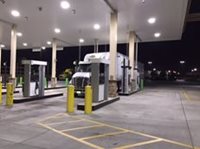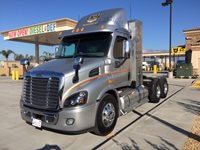Upon my last report on fuel mileage and CNG pricing, diesel was spiking somewhere around $4.00 per gallon here in California. Shortly thereafter, the price of diesel began its downward spiral to record low prices not seen in years. In doing so, I will be the first to admit that some of the fuel savings I was seeing from having natural gas instead of diesel as my fuel source started to diminish. When diesel hit its lowest point, the price gap between the two fuels was pretty much at dead even. The rapid decrease in diesel price, caused by decreased demand and increased supply of crude, happened so fast that natural gas prices were left running to catch up.
 Being a domestically produced fuel, natural gas is not as susceptible to these outside factors that lead to the rapid changes in diesel prices. This decreased vulnerability can be a good thing when diesel fuel is spiking, but it can also leave you wondering, “What’s going on here?” when diesel falls and natural gas stays its typically steady course. I had always boasted to others that I was able to pay around $2.21 per GGE (Gas Gallon Equivalent) here in California, which works out to about $2.48 per DGE (Diesel Gallon Equivalent), during the first year of driving this truck. Running just above a 5mpg average running locally, when the diesel prices hit record lows, it began to blur the line between pump prices for CNG and operating efficiency.
Being a domestically produced fuel, natural gas is not as susceptible to these outside factors that lead to the rapid changes in diesel prices. This decreased vulnerability can be a good thing when diesel fuel is spiking, but it can also leave you wondering, “What’s going on here?” when diesel falls and natural gas stays its typically steady course. I had always boasted to others that I was able to pay around $2.21 per GGE (Gas Gallon Equivalent) here in California, which works out to about $2.48 per DGE (Diesel Gallon Equivalent), during the first year of driving this truck. Running just above a 5mpg average running locally, when the diesel prices hit record lows, it began to blur the line between pump prices for CNG and operating efficiency.
 Now that diesel has began its slow, but steady climb back up to where we all knew it would return eventually, natural gas has started to catch up in its own way. A slow but steady decrease in natural gas prices in my area has pump prices weighing in around $1.85 per GGE, or around $2.07 per DGE. Now that I have been operating for a year, I am beginning to see operating efficiency of 5.62mpg and gaining towards the 6mpg mark at a steady pace. Working in all these factors, along with the average pump price of diesel in my area of $3.16 (up another 5 cents from a week ago according to http://www.eia.gov/petroleum/gasdiesel/), it appears that it is still a profitable decision to operate one of these CNG trucks in a market where others running diesel trucks are lucky to see 7mpg (on paper). Of course, as the pricing gap between diesel and natural gas narrows, one must take into consideration the increase in payback period for the upcharge on running natural gas. Other factors to consider are the availability of grants and tax credits towards the purchase and use of these types of vehicles, which can drastically reduce payback period and help maximize the price advantage of natural gas even faster. Basic rule of thumb for any truck though, with CNG being no different…The more you run it, the quicker it’ll pay for itself.
Now that diesel has began its slow, but steady climb back up to where we all knew it would return eventually, natural gas has started to catch up in its own way. A slow but steady decrease in natural gas prices in my area has pump prices weighing in around $1.85 per GGE, or around $2.07 per DGE. Now that I have been operating for a year, I am beginning to see operating efficiency of 5.62mpg and gaining towards the 6mpg mark at a steady pace. Working in all these factors, along with the average pump price of diesel in my area of $3.16 (up another 5 cents from a week ago according to http://www.eia.gov/petroleum/gasdiesel/), it appears that it is still a profitable decision to operate one of these CNG trucks in a market where others running diesel trucks are lucky to see 7mpg (on paper). Of course, as the pricing gap between diesel and natural gas narrows, one must take into consideration the increase in payback period for the upcharge on running natural gas. Other factors to consider are the availability of grants and tax credits towards the purchase and use of these types of vehicles, which can drastically reduce payback period and help maximize the price advantage of natural gas even faster. Basic rule of thumb for any truck though, with CNG being no different…The more you run it, the quicker it’ll pay for itself.